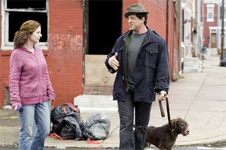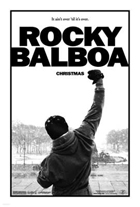Rocky Balboa
|  It is all too appropriate that Sylvester Stallone is returning to South Philly pugilist Rocky Balboa, the character who kicked off his career and with whom he will always be most associated. The original Rocky (1976) was an allegory (self-conscious or not) of Stallone’s own life at the time--as a bit player who had written a script that he refused to sell unless he was allowed to play the lead, Stallone was given a one-in-a-million shot and, just like his mumbling screen persona, scored huge. It is all too appropriate that Sylvester Stallone is returning to South Philly pugilist Rocky Balboa, the character who kicked off his career and with whom he will always be most associated. The original Rocky (1976) was an allegory (self-conscious or not) of Stallone’s own life at the time--as a bit player who had written a script that he refused to sell unless he was allowed to play the lead, Stallone was given a one-in-a-million shot and, just like his mumbling screen persona, scored huge.Now, as a has-been movie star who hasn’t had a genuine hit in more than a decade, Stallone gives us Rocky Balboa, the sixth installment of the 30-year-old Rocky franchise, to once again function as an on-screen allegory for his own current condition: a has-been reaching back into the past to reclaim at least a shard of former glories. What is remarkable about Rocky Balboa, which is otherwise a rather unremarkable movie, is how transparent Stallone is in accepting his has-been status and returning to the role of the underdog. (Although, to be fair, Rocky has always been the underdog in his films, usually because his opponents just kept getting bigger and bigger, culminating in Rocky IV’s Soviet battering ram Ivan Drago.) Rocky Balboa is all formula, but there is something so direct and pure about it that it’s hard to begrudge Stallone for going straight back to the source. In many ways, the film plays like a greatest hits parade of favorite Rocky moments resituated in the 21st century, but with barely an ounce of change. The South Philadelphia setting is back, as is Rocky’s frumpy leather jacket and slightly comical porkpie hat. He pounds on slabs of hanging meat, gulps down raw eggs, does one-armed push-ups, and has several evocative monologues about pride, determination, and never giving up. Even the training montage set to Bill Conti’s immortal “Gonna Fly Now” theme, which had been dropped from the series back in Rocky IV (1985) and has been mercilessly lampooned by the likes of South Park creators Matt Parker and Trey Stone, is resurrected, culminating with Balboa charging once again to the top of the Philadelphia Museum of Art’s steps. But, that doesn’t matter to Stallone because Rocky exists outside the realm of postmodern pastiche, parody, and irony. Those who turn up for a sixth helping of Balboa, now 60 years old, don’t want to see any botched attempts to “improve” the formula or “update” the franchise. Rather, they want to see Rocky put through the motions once more, proving again that heart, sweat, and decency will always trump braggadocio, ego, and fancy work-out equipment. The Rocky movies, even the ones that began to resemble cartoons, were always about the power of the human spirit as embodied in a big palooka from South Philly, and Rocky Balboa fits right in line. It’s been 16 years since Rocky was on-screen in 1990’s Rocky V, which reunited Stallone with original Rocky director John G. Avildsen, yet failed to move audiences. Stallone, who wrote, produced, and directed the new film, essentially pretends that Part V never existed. When the story opens, Rocky is widowed, his beloved Adrian (Talia Shire, glimpsed only in brief flashbacks) having died three years earlier. However, Adrian’s perpetually drunk brother Paulie (Burt Young) is still alive and comically bitter as ever. Rocky makes a living running a small Italian restaurant named after his wife that is bedecked with his heavyweight fighting memorabilia. Each night he works the room, wearing a red dinner jacket, telling old battle stories, and taking pictures with his bemused patrons. He seems only barely resigned to this existence, which is why it doesn’t come as much of a surprise when he jumps at the chance to re-enter the ring. The impetus comes from a computerized fantasy boxing match aired on ESPN that pits Balboa in his prime against current heavyweight champ Mason “The Line” Dixon (Antonio Tarver), a powerhouse who has yet to be truly challenged. The computer suggests that Rocky would have won the match by a knockout, which inspires Dixon’s cagy promoters to suggest an exhibition match with the real deal. The idea of a retired 60-year-old boxer with arthritis and calcium deposits on his bones entering the ring with the current champ and lasting more than half a round is the preposterous stuff of fantasy, but to an extent that’s what the Rocky movies are all about. Although the early entries to which this film aspires were grounded in the nitty-gritty realities of a hardscrabble working-class existence, they suggest that once-in-a-lifetime opportunities not only exist, but are the very stuff of the American dream. For all its good intentions, Rocky Balboa falters in some of its dramatics, particularly Rocky’s relationship with his twentysomething son, Rocky Jr. (Milo Ventimiglia), an aspiring stock broker who resents living in his father’s shadow. Their scenes together feel forced, and Rocky Jr.’s eventual coming around is too rote to have any emotional kick. Rocky also strikes up a relationship with Marie (Geraldine Hughes), who astute Rocky fans will remember as the troubled preteen in the 1976 original who responded to Rocky’s life advice by saying, “Screw you, jerk-o.” Now a bartender and single mother, she becomes Rocky’s new improvement project and possible romantic interest. The inevitable fight at the end is everything you would expect it to be, even if this time it was filmed in high-definition video. It plays right along with the Rocky formula, inviting us to believe that Rocky might actually be completely outmatched before the thundering Southpaw starts landing body blows. Perhaps in an attempt to liven up the proceedings, Stallone and cinematographer J. Clark Mathis introduce some jarring and ineffective visual flourishes, including images drained of all color except one or two, most notably blood. While most likely intended to draw attention to the damage and hurt inflicted in heavyweight boxing, it mostly serves to make the film look like a Gatorade commercial. Nevertheless, Rocky Balboa is much better than it ought to be. There isn’t much more Stallone can do with this particular character except take him through the same paces we’ve seen before with mostly the same results. Yet, there is such poignancy to Rocky Balboa, especially in his advanced years and having been returned to the place in life where we first met him, that the film maintains a genuine effectiveness, its final fade-out gently suggesting that the more things change, the more they stay the same. Copyright ©2006 James Kendrick Thoughts? E-mail James Kendrick All images copyright ©2006 Metro Goldwyn Mayer |
Overall Rating: 

 (3)
(3)


